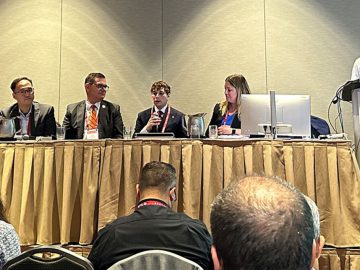Summary
Georgia-Pacific, KONE and Carrier are turning to generative AI to improve workforce, energy efficiency and optimize operations.
How Three Century-old Manufacturers Are Turning to Generative AI
According to research from McKinsey & Company, generative AI’s annual value in manufacturing ranges from an estimated $2.6 trillion to $4.4 trillion. These numbers paint a picture of how much manufacturing companies are trusting Generative AI to transform the manufacturing landscape. In fact, many industry leaders are actively exploring its potential. Century-old companies such as Georgia-Pacific, KONE and Carrier are seizing the opportunity to build solutions that optimize operations, improve workforce productivity and more easily scale products.
Optimizing manufacturing operations
Georgia-Pacific, a global leader in paper-based products and packaging, operates multiple manufacturing facilities across North America. They produce hundreds of paper rolls and millions of paper and tissue finished goods daily through a very intricate process which is tracked by thousands of sensors. Any potential tears or breaks during the manufacturing process not only disrupts operations but also incurs substantial costs – in the millions of dollars annually.
One of the challenges with this process was the difficulty to gain actionable insights into the causes of these potential production interruptions. Unfortunately, Georgia-Pacific suffered from fragmented data sources and the impending retirement of internal experts who understood site-specific machine intricacies and the variables which were the basis of these issues. The experienced operators knew these telling signs often before the machine was able to predict the failure, and were able to quickly mitigate the issue. New operators did not have this knowledge and disruptions within operations were increasing.
To address this, Georgia-Pacific looked to generative AI, implementing a solution that organizes a vast array of machine data. As a result, staff can now support continuous operations and facilitate the onboarding of new machine operators across its enterprise. This generative AI solution transformed Georgia-Pacific’s troubleshooting and training processes. Now, operators can quickly retrieve real-time guidance and diagnostic information while significantly reducing troubleshooting time from hours to less than a minute.
This efficiency boost ensures product quality, safety and environmental stewardship. Moreover, it minimizes material defects and waste. This success has led Georgia-Pacific to deploy the generative AI solution in control rooms across select operations and has also prompted plans for broader implementation across its manufacturing facilities.
Increasing worker productivity and customer satisfaction
In addition to streamlining internal manufacturing processes, generative AI is also enhancing worker productivity and, ultimately, customer satisfaction. KONE, an organization at the forefront of elevator and escalator maintenance and repairs, worked with AWS to develop a generative AI-driven Assistant for field technicians. This allows each technician to better serve customers using KONE’s elevators and escalators.
With thousands of elevators in its client base, KONE technicians must be able to maintain all the different models and variances. Previously, when errors occurred, technicians had to manually find the right information to correct the fault, often from paper based repositories. This was quite tedious with the decades worth of data in KONE’s systems.
However, after integrating KONE’s vast repositories of technical documentation and help desk case libraries into its AI tool, maintenance workers are now able to retrieve information of the different elevator types within seconds. This advancement means technicians can easily rectify faults, reduce downtime and overall increase their job satisfaction. The ultimate result? Heightened customer satisfaction thanks to enhanced service.
Empowering sustainability in manufacturing
Generative AI is also the foundation for sustainability initiatives in manufacturing. For example, Carrier Global Corporation (Carrier), a leading provider of building and cold chain solutions, is leveraging generative AI in its mission to foster sustainable and efficient building environments.
Central to that mission is the advancement of products like Abound Net Zero Management, which maximizes energy efficiency and reduces carbon footprints in buildings globally. Carrier wanted to scale this product beyond the U.S. for a global audience. They especially wanted to focus on managing and interpreting diverse utility data across different regions and languages. To do this, Carrier developed a generative AI system that enhances the utility and effectiveness of its Abound Net Zero Management solution. The platform consolidates and analyzes an array of energy consumption and emissions data sourced from utility providers worldwide.
By tapping into historical data, previous operational insights, and predictive analytics, building managers globally can use Abound Net Zero Management to optimize energy usage with precision. This strategic initiative has helped advance Carrier’s commitment to leveraging technology that drives environmental stewardship and operational excellence across diverse global markets.
Realizing this is just the beginning
The adoption of generative AI has become a strategic imperative for the manufacturing companies. Industry leaders like Georgia-Pacific, KONE and Carrier are just a few examples of generative AI’s promises turning into reality for the industry. Many more companies are building and implementing solutions that have optimized operations, boosted productivity and helped them innovate at scale to propel their businesses. These successes offer insights on the value of generative AI adoption in manufacturing and what’s already working. With generative AI still in its early stages, this is only the tip of the iceberg of what’s to come in manufacturing.
Did you enjoy this great article?
Check out our free e-newsletters to read more great articles..
Subscribe





